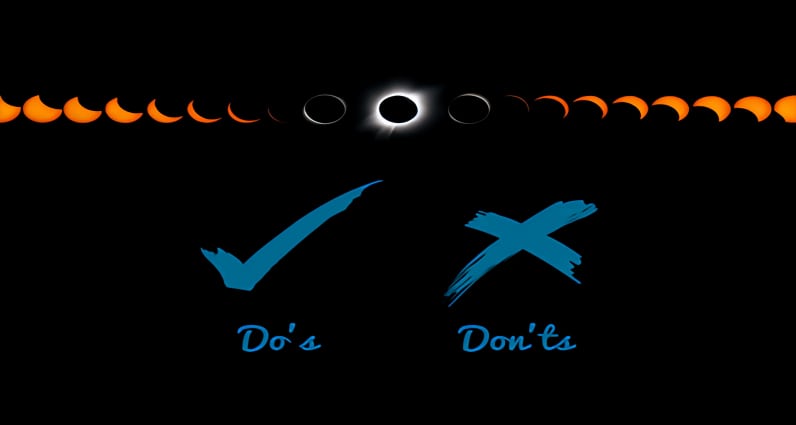This is the sixth installment in a series about the upcoming total solar eclipse of April 8, 2024. Villagers are very fortunate to be directly aligned with the path.
DO NOT look at the sun with your naked eyes. Permanent damage to your eyesight, and even blindness, may result. ALWAYS wear certified solar viewing glasses (ISO 12312-2 international standard compliant) when viewing the sun before, during, and after an eclipse. We have all glanced at the sun, but prolonged exposure causes permanent damage. During an eclipse, when the moon covers a portion of the sun, the intensity of the light remains constant. The ONLY time it is safe to look toward the sun with the naked eye is during the brief period of totality at the height of a total eclipse of the sun.
DO NOT point a camera at the sun unless the optics are fitted with a certified solar filter. Optics can magnify the intensity and brightness of sunlight, and this can cause damage to your equipment.
DO NOT look through the viewfinder of an unfiltered SLR camera when it is pointed at or near the sun because of the increase in intensity and brightness of the sunlight passing through magnifying optics. Remember that even though you may have a filter on the camera lens, the viewfinder is not looking through the lens and is thus unprotected.
DO NOT look through the viewfinder of a rangefinder camera when it is pointed at or near the sun, as the optical viewfinder will not protect your eyes from the sun’s damaging light.
DO NOT point an unfiltered digital camera at the sun and use live view or an electronic viewfinder due to the possibility of focusing concentrated, unfiltered sunlight at your camera’s sensor.
Looking at the Sun through a viewfinder, telescope, or binoculars without blocking any light can result in immediate loss of vision – it will literally burn a hole in your retina! Keep in mind that looking through a lens is similar to using a magnifying glass or loupe…very dangerous. It is a pretty serious matter, so it is absolutely critical that you take necessary precautions.
DO:
- Use protective eyewear, such as welder’s glasses or solar certified glasses
- If photographing: (more detailed information will follow in subsequent articles)
- Use a solar filter to protect your DSLR camera sensor
- Use a tripod or mount to avoid a blurry photo
- Manually focus your camera
- Set your camera settings before the solar eclipse — test those settings on a non-eclipse day
- Use a high ISO setting and high resolution — to keep exposures very short and prevent blurring from vibrations
- A solar eclipse is not an everyday event. Some people will go their entire lives without witnessing one. Some will travel far and wide to try to see one or more in a lifetime—especially for rare total solar eclipses. So, what you DO NOT want to do is spend an entire eclipse event messing around with your camera gear or viewing it entirely through a camera’s viewfinder or on an LCD screen. LOOK at the eclipse. Enjoy it with your own (protected) eyes. As amazing as it would be to get a great photograph, you will have a lifetime of regrets if you miss the whole show because you are hyper-focused on photographing the event.
The HSV Camera Club and Village Stargazers will continue to post information articles on the solar eclipse. Over the next few weeks, we will cover various photographing options, equipment needed, and how to use them.
References: B&Hphotovideo.com How to Photograph a Solar Eclipse By Todd Vorenkamp
By HSV Camera Club and Village Stargazers
Click here to view “2024 Total Solar Eclipse – When and Where to View.”
Click here to visit the HSV Camera Club website.
Click here to visit the Hot Springs Village Stargazers Facebook Page.
Click here to visit the official Hot Springs Village POA Facebook Page.


